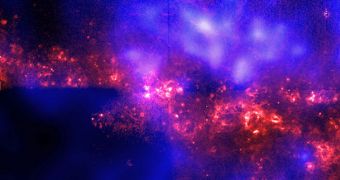Astronomers have determined that the entire Universe is permeated by what could best be described as an ancient signature at a subatomic level, which may yield additional details about how everything came into being.
Some of the particles in this signature apparently have the ability to exist in a large number of places across the Cosmos at the same time. These small particles are apparently the effects of the action of creating reality, as it took place at the time of the Big Bang.
That even took place more than 13.7 billion years ago. A couple hundred million years later, the cosmic microwave background (CMB) was born, a large deposit of photons produced when the Universe was born. These photons can be seen in a relatively uniform layer everywhere you look in the sky.
It would appear however that, in addition to these photons, “relic” neutrinos also exist throughout the Cosmos. These particles are apparently all that remains from a time when the Universe was nothing but a hot and dense mass, shortly after the Big Bang.
During that time, seconds after the initial event, there existed a very large number of states of matter, as well as various dimensions of space and time. The current thinking goes that some of them collapsed in on themselves to form the stable ones we experience today.
The relic neutrinos that scientists discovered have been heavily stretched out by the ever-accelerated expansion of the Universe, a phenomenon that is apparently driven by dark energy. Experts believe that a huge blast wave of neutrinos was released shortly after the Big Bang.
“We're talking maybe up to roughly ten billion light-years [for each of these particles]. That's nearly on the order of the size of the observable Universe,” explains George Fuller, who is a researcher at University of California in San Diego.
The expert is also the co-author of a new study detailing the findings, which was conducted with student Chad Kishimoto. The team learned that the very fabric of space-time is responsible for pulling ancient neutrinos apart, Daily Galaxy reports.
This is what cause the stretching of these particles; ranges over such vast distances. One of the things the researchers are pondering on is whether such a meganeutrino can be forced to collapse to a single location and time by a force such as for example gravity.
“Quantum mechanics was intended to describe the Universe on the smallest of scales, and now here we're talking about how it works on the largest scales in the Universe. We're talking about physics that hasn't been explored before,” Kishimoto explains.
“Gravity is a real frontier these days that we don't really understand. These neutrinos could be a path to something deeper in our understanding with gravity,” explains University of California in Berkeley (UCB) physicist Adrian Lee, who was not a part of the investigation.

 14 DAY TRIAL //
14 DAY TRIAL //